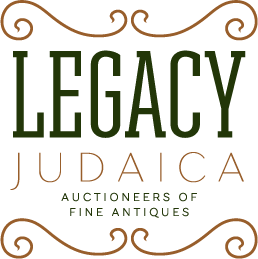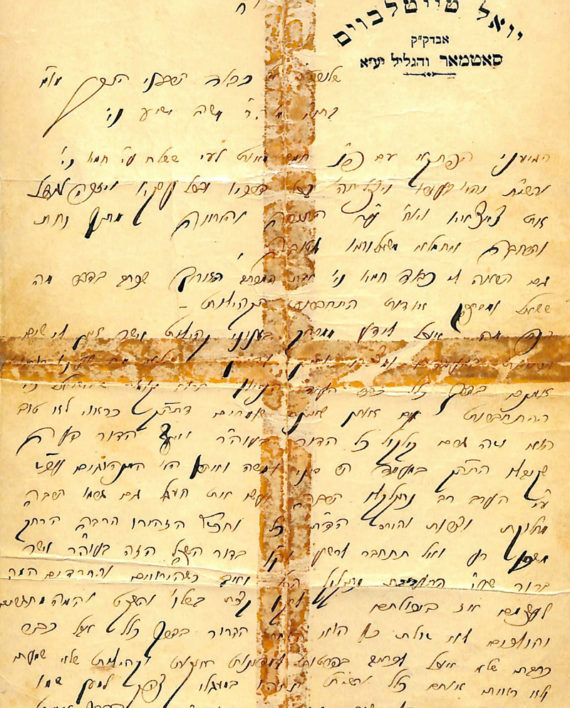Teitelbaum, R. Yoel / Satmar / Khal Charedim archives. Lot of five items.
In the 1920’s Congregation Khal Charedim was established in New York’s Lower East Side by a group of devout and G-d-fearing individuals of Hungarian origin who, due to various circumstances, found themselves in America. Determined to uphold their traditions and unwilling to compromise one iota from their religious standards, they founded Khal Charedim. The bylaws of the kehilla only permitted membership to like-minded individuals who undertook that they and their spouses would maintain the accepted religious and Chassidic standards practiced in Europe. This was almost unprecedented in an era where the prevailing attitude was, that the European standards of yiddishkeit could not survive and certainly not flourish in America.
Although originally the community did not have an official Rav, in 1938 they appointed a renowned European Rav to that position. The Rav had narrowly escaped the Nazi invasion of Austria and without a position waiting for him in the US could not have obtained an entry visa. This official Rav however, did not settle in the Lower East Side but in Williamsburg where he opened his own Bais Ha’Midrash. The times being what they were and with only one main supporter helping him to establish himself in America, the Rav felt compelled to overlook the sad fact that the family of the lay-leader of his new kehilla were lax in certain areas of religious behavior. Although the new kehilla too, was strictly orthodox they did not require the same personal standards from their members and their families as did Khal Charedim.
A disagreement arose whether the official Rav of the Khal Charedim could preside at the same time over a second congregation which did not necessarily conduct itself in accordance with the Khal Charedim standards. The president of Khal Charedim, Reb Moshe Shea Ha’Cohen Perl, presented the question to R. Yoel Teitelbaum then serving as Rav in the City of Satmar, Romania. Orthodox Jewry was a crossroads at this critical juncture and the dilemma posed to the Satmar Rav would have ramifications that would decide the very fabric of Orthodox life in the New World. On the one hand, one of the leading Torah personalities of the time had reached the shores of America and stood poised to elevate the general populace. Here was an opportunity for the Satmar Rav to urge the people to accept the Rav’s leadership. On the other hand, this small existing bastion of undiluted yiddishkeit was asking that even a tiny breach not be allowed in the wall that they had erected to maintain their age-old standards.
This historic handwritten letter sent by the Satmar Rav declared that there was no room for compromise. Upon the receipt of the Satmar Rav’s response, the official Rav of Khal Charedim felt compelled to resign. As he was in fact established in Williamsburg, the resignation was basically a formality, but to the devout Jews sacrificing themselves daily to maintain the standards of old, it was a watershed event. The Satmar Rav had spoken: America would no longer be the land of compromise.
Subsequently in 1948, when the Satmar Rav immigrated to America, it was the same Khal Charedim which signed the required affidavit legally bringing the Rebbe to America to serve as their Rav.
Signed letter by Rav Yoel Teitelbaum of Satmar written to R. Moshe Shea Perl, president of Khal Charedim. The Rebbe responded that whilst queries of this nature cannot be answered under any circumstances from a distance, generally speaking one should maintain total separation from those who compromise their religious standards. The Rebbe added that the “Eigel” made in the desert shortly after the receiving of the Torah was due to the influence of “Eirev Rav” and the Jew’s association with them.
Although written prior to the Holocaust and the subsequent immigration of the Rebbe to America, this letter provides a glimpse into the foresight and worldview of the Rebbe, and can be considered the document which laid the foundation upon which “Satmar” would be established a decade later in America.
23 by 14 cm. Some stains. Laminated.
Minutes of a board meeting of the executive committee of Khal Charedim dated 1946, unanimously agreeing to appoint the Satmar Rav as Rav of the Kehilla.
Two letters from the State Department written to Reb Moshe Shea Perl confirming that the Rebbe will be arriving in New York Harbor on September 12th 1948.
Original booklet with the constitution and bylaws of Khal Charedim.
Opening bid $10,000
טייטלבוים, ר’ יואל/סטמאר/ארכיון קהל חרדים. אוסף של 5 פריטים
קהילת קהל חרדים נוסדה בשנות תר”פ בלואר איסט סייד בניו יורק על ידי קבוצת יהודים יראים ושלמים ממוצא הונגרי שהגיעו לאמריקה בנסיבות שונות. נחישותם לדבוק במסורת ולא לוותר על קוצו של יוד בחומרותיהם הדתיות דרבנה אותם ליצור את קהל חרדים. לפי חוקי הקהילה, ההשתייכות לקהילה הותרה אך ורק לאנשים בעלי השקפה דומה שהתחייבו כי הם ובני זוגם יקפידו על הסטנדרטיים הדתיים והחסידיים הנהוגים באירופה. התחייבות זו הייתה כמעט חסרת תקדים בעידן שבו הדעה הרווחת הייתה שהסטנדרטים הדתיים האירופאיים לא יוכלו לשרוד ובוודאי לא לשגשג באמריקה
לקהילה לא היה רב רשמי לכתחילה, אולם בשנת תרצ”ח (1938) התמנה רב אירופאי נודע למשרה זו. הרב חמק מהפלישה הנאצית לאוסטריה, וללא משרה הממתינה לו בארצות הברית הוא לא היה משיג אשרת כניסה. אולם, רב רשמי זה לא התיישב בלואר איסט סייד אלא בוויליאמסבורג, שם פתח בית מדרש משלו.תמיכתו העיקרית נבעה מאדם אחד שעזר לו להתבסס באמריקה. בצוק העתים, הרב נאלץ להתעלם מהעובדה המצערת שמשפחת המנהיג של קהילתו החדשה מתרשלת בתחומים מסוימים בדת. הקהילה החדשה אמנם הקפידה על קלה כבחמורה, אך הסטנדרטים האישיים שנדרשו מחברי הקהילה ובני משפחתם לא דמו לאלו של קהל חרדים
התעוררה מחלוקת האם הרב הרשמי של קהל חרדים יכול לעמוד בעת ובעונה אחת בראש קהילה אחרת שאינה מתנהלת בהכרח לפי אמות המידה של קהל חרדים. נשיא קהל חרדים, ר’ משה יהושע הכהן פארל, הציג את השאלה בפני ר’ יואל טייטלבוים שכיהן באותה עת כרב בעיר סטמאר, רומניה. היהדות החרדית עמדה בפני פרשת דרכים בשעה קריטית זו, והדילמה שהוצבה בפני הרב מסטמאר הייתה כבדת משקל באשר להשלכותיה על החיים האורתודוקסיים בעולם החדש. מחד גיסא, אחד מגדולי התורה של אותו דור הגיע לחופי אמריקה ועמד לרומם את המון העם. זו הייתה הזדמנות עבור הרב מסטמאר לדרבן את הציבור לקבל את מרותו. מאידך גיסא, מבצר קטן זה של יהדות בלתי מתפשרת ביקשה למנוע גם את הסדק הקטן ביותר בחומה שהם הקימו לביצור אורח חייהם מקדמת דנא
מכתב היסטורי זה בכתב יד שנשלח על ידי הרב מסטמאר הכריז שאין מקום לפשרות. לאחר קבלת תשובתו של הרב מסטמאר, הרב הרשמי של קהל חרדים הרגיש כי עליו להתפטר מתפקידו. היות שהוא היה ממוקם למעשה בוויליאמסבורג, ההתפטרות הייתה פורמלית בלבד, אך עבור היהודים האדוקים שמסרו את נפשם מדי יום ביומו לקיום מנהגיהם מקדמת דנא, הייתה זו נקודת מפנה. הרב מסטמאר אמר את דברו: אמריקה כבר לא תהיה מדינת הפשרות
מאוחר יותר, בשנת תש”ח (1948), כאשר הרב מסטמאר היגר לאמריקה , קהל חרדים חתם על התצהיר הדרוש ובכך הביאו את האדמו”ר לאמריקה באופן חוקי לשמש כרבם
מכתב חתום על ידי ר’ יואל טייטלבוים מסטמאר לר’ משה יהושע פארל, נשיא קהל חרדים. האדמו”ר ענה שאף על פי ששאלות מסוג זה אינן יכולות להיענות בשום אופן ממרחקים, באופן כללי יש להתנתק לגמרי מאנשים המתפשרים על הסטנדרטים הרוחניים שלהם. האדמו”ר הוסיף שעגל הזהב נבנה במדבר לאחר קבלת התורה בהשפעת הערב רב והקשר של העם אתם
על אף שמכתב זה נכתב טרם השואה והגירת הרבי לאמריקה לאחר מכן, הוא מספק הצצה לחזונו והשקפת עולמו של האדמו”ר ונחשב למסמך שהניח את התשתית שעליה הוקמה חסידות סטמאר באמריקה כעבור עשור
23X14 ס”מ מעט כתמים. למינציה
פרוטוקול ישיבת מועצה של מועצת המנהלים של קהל חרדים משנת תש”ו (1946). המשתתפים הסכימו פה אחד למנות את הרב מסטמאר לרב הקהילה
שני מכתבים ממשרד מחלקת המדינה של ארצות הברית לר’ משה יהושע פארל, המאשרים שהאדמו”ר יגיע לנמל ניו יורק ב-12 בספטמבר תש”ח (1948
קונטרוס מקורי עם החוקה וחוקי העזר של קהל חרדים.
פתיחה $10,000










